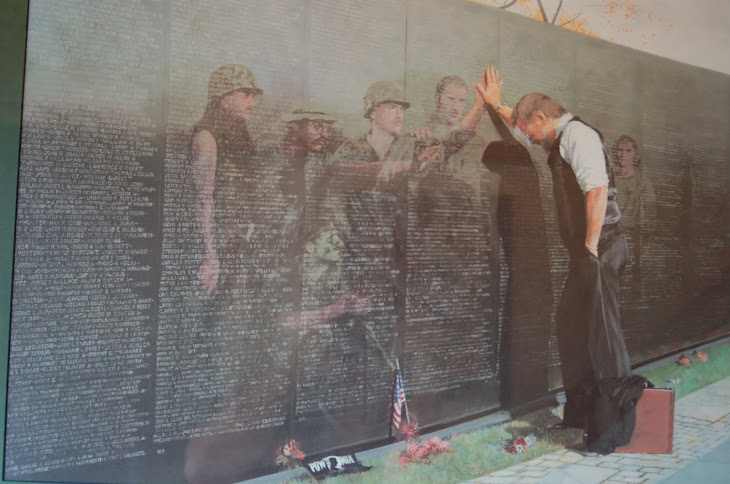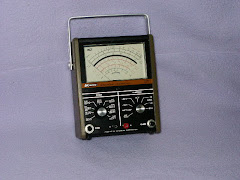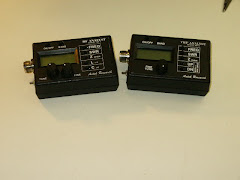08 April, 2009
Amateur Radio Missionary Service (ARMS)
ARMS, call sign KA2RMS is a national group of fellow "ham operator" believers, who know and love the Lord as their personal Savior. Check out the web site for more information. Gal. 6:10 As we therefore have opportunity, let us do good unto all men, especially those who are of the household of faith.
07 April, 2009
Flex Radio Part 1 - Page 2
The first truly Open Source Software Defined Amateur Radio Transceiver. The SDR -1000 as well as the other newer model products in the Flex line, 1500, 3000, 5000A and 5000D all define the modulation waveforms in software (SDR). Keep in mined that that most traditional analog radios are fixed in capability for all time. Since all the functionality is hard wired in the radio, there is little ability to upgrade.
Many more modern radios add proprietary digital signal processing (DSP) chips to traditional analog radio architecture to provide signal processing functions with rather limited or little capability to upgrade.
The Flex Radio SDR-1000 was the first open source software, amateur radio transceiver to incorporate the scalable DSP performance of a personal computer (PC) and sound card to perform all modulation, demodulation, and control functions of the radio.
If you take a good hard look at the technology today, you will see that the general purpose PC architecture, now vastly outperforms even the best of the proprietary (DSP) chips, always keeping in mine that the SDR allows for upgrades as new improvements come along with no hardware changes. The SDR 1000D which I currently have and use, has had at least 5 0r 6 software upgrades with no changes to hardware, except for performance! The upgrades are as simple as going to the Flex Radio web site and downloading the newest version of software to a thumb drive, which is the process that works for me, as I can download my upgrades regardless of were I might be!
The other aspect of technology that has driven SDR capabilities, is the professional audio market with constant and significant improvements in sound card technology. This is one of the major advantages of these trends as they provide upgradeable hardware performance through software improvements.
In the next part of this series, we will look at how almost ever function is done in software. Then we will look at the SDR-1000D physical hardware and the functions of the hardware components.
Many more modern radios add proprietary digital signal processing (DSP) chips to traditional analog radio architecture to provide signal processing functions with rather limited or little capability to upgrade.
The Flex Radio SDR-1000 was the first open source software, amateur radio transceiver to incorporate the scalable DSP performance of a personal computer (PC) and sound card to perform all modulation, demodulation, and control functions of the radio.
If you take a good hard look at the technology today, you will see that the general purpose PC architecture, now vastly outperforms even the best of the proprietary (DSP) chips, always keeping in mine that the SDR allows for upgrades as new improvements come along with no hardware changes. The SDR 1000D which I currently have and use, has had at least 5 0r 6 software upgrades with no changes to hardware, except for performance! The upgrades are as simple as going to the Flex Radio web site and downloading the newest version of software to a thumb drive, which is the process that works for me, as I can download my upgrades regardless of were I might be!
The other aspect of technology that has driven SDR capabilities, is the professional audio market with constant and significant improvements in sound card technology. This is one of the major advantages of these trends as they provide upgradeable hardware performance through software improvements.
In the next part of this series, we will look at how almost ever function is done in software. Then we will look at the SDR-1000D physical hardware and the functions of the hardware components.
05 April, 2009
Flex Radio System Part 1
For those of you who enjoy technology, I believe you will find this post interesting, informative and maybe even fun, as you learn a bit about a new communications technology called; Flex Radio!
There has been just a ton of articles generated about Flex Radio, or as it is also called (SDR)Software Defined Radio. One of the things I would like to do in this post, is to define Flex Radio and how it is used. So lets start with with a definition, What is Flex Radio or Software Defined Radio ? It is a collection of hardware and software technologies that enables a reconfigurable system architecture for use in wireless communications. This definition is taken for the 2007 Data Sheet on one of the SDR radio system, the SDR-1000 which was the original Flex Radio hardware developed.
This type architecture provides an efficient and comparatively priced solution to the problem of building a multi-mode, multi-band, and multi-function communications devise that can be enhanced using software upgrades.
The SDR 1000 which was developed from Flex Radio Systems, of Austin, Tx., is the system which I will be using throughout this series of posts. SDR 1000 is the actual hardware component of a complete (SDR) Software Defined Radio transceiver which is then interfaced to a Windows based Personal Computer. The SDR 1000 provides everything that is needed to convert a PC into a high performance, 11khz-65Mhz general coverage receiver with 160meter to 6meter (2meter optional) Amateur Radio band transmit capability.
Ok, here we go, as we are going to look at some really technical terminology. As we go along we will define the terms which we will use here and in later parts of the series. The SDR -1000 incorporates a "novel" Quadrature Sampling Detector (QSD) which provides a high dynamic range with minimal components. An Analog Devise AD9854 quadrature DDS and 200Mhz 1ps jitter clock oscillator provides continuous coverage with a very low phase nosie. The SDR-1000
will deliver 100watts PEP (40watts continuous) on the 160meter-10meter (50watts on 60meters) HF bands with the optional SDR-100watt PA linear amplifier.
The combination of the (QSD), quadrature Sampling Detector and the (DSP) Digital Signal Processing, produces a transceiver that has superior performance over conventional radios and easily upgraded with new software features provided at no additional cost. Receiver dynamic range and selectivity are in the top performance class of all amateur radio transceivers.
Before we go any further, just let me say that there are several models of SDR systems. The Flex 1000 is no longer produced. The newest model is the (1) Flex 1500 which will be available early this year. (2) Flex 3000, (3) Flex 5000A, and (4) Flex 5000C. Each of these will be reviewed later.
There has been just a ton of articles generated about Flex Radio, or as it is also called (SDR)Software Defined Radio. One of the things I would like to do in this post, is to define Flex Radio and how it is used. So lets start with with a definition, What is Flex Radio or Software Defined Radio ? It is a collection of hardware and software technologies that enables a reconfigurable system architecture for use in wireless communications. This definition is taken for the 2007 Data Sheet on one of the SDR radio system, the SDR-1000 which was the original Flex Radio hardware developed.
This type architecture provides an efficient and comparatively priced solution to the problem of building a multi-mode, multi-band, and multi-function communications devise that can be enhanced using software upgrades.
The SDR 1000 which was developed from Flex Radio Systems, of Austin, Tx., is the system which I will be using throughout this series of posts. SDR 1000 is the actual hardware component of a complete (SDR) Software Defined Radio transceiver which is then interfaced to a Windows based Personal Computer. The SDR 1000 provides everything that is needed to convert a PC into a high performance, 11khz-65Mhz general coverage receiver with 160meter to 6meter (2meter optional) Amateur Radio band transmit capability.
Ok, here we go, as we are going to look at some really technical terminology. As we go along we will define the terms which we will use here and in later parts of the series. The SDR -1000 incorporates a "novel" Quadrature Sampling Detector (QSD) which provides a high dynamic range with minimal components. An Analog Devise AD9854 quadrature DDS and 200Mhz 1ps jitter clock oscillator provides continuous coverage with a very low phase nosie. The SDR-1000
will deliver 100watts PEP (40watts continuous) on the 160meter-10meter (50watts on 60meters) HF bands with the optional SDR-100watt PA linear amplifier.
The combination of the (QSD), quadrature Sampling Detector and the (DSP) Digital Signal Processing, produces a transceiver that has superior performance over conventional radios and easily upgraded with new software features provided at no additional cost. Receiver dynamic range and selectivity are in the top performance class of all amateur radio transceivers.
Before we go any further, just let me say that there are several models of SDR systems. The Flex 1000 is no longer produced. The newest model is the (1) Flex 1500 which will be available early this year. (2) Flex 3000, (3) Flex 5000A, and (4) Flex 5000C. Each of these will be reviewed later.
Subscribe to:
Comments (Atom)








